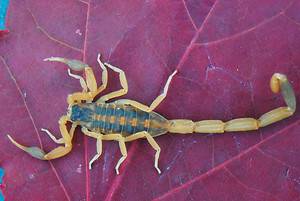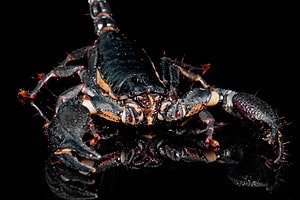Scorpions are fascinating arachnids that have captured human curiosity for centuries. With their distinctive appearance, including segmented bodies and menacing stingers, scorpions are creatures of wonder and fear.
Found on every continent except Antarctica, these ancient arachnids have adapted to various environments, from deserts to rainforests. Let’s delve into interesting facts surrounding baby scorpions.
1. Baby Scorpions Can Glow in the Dark
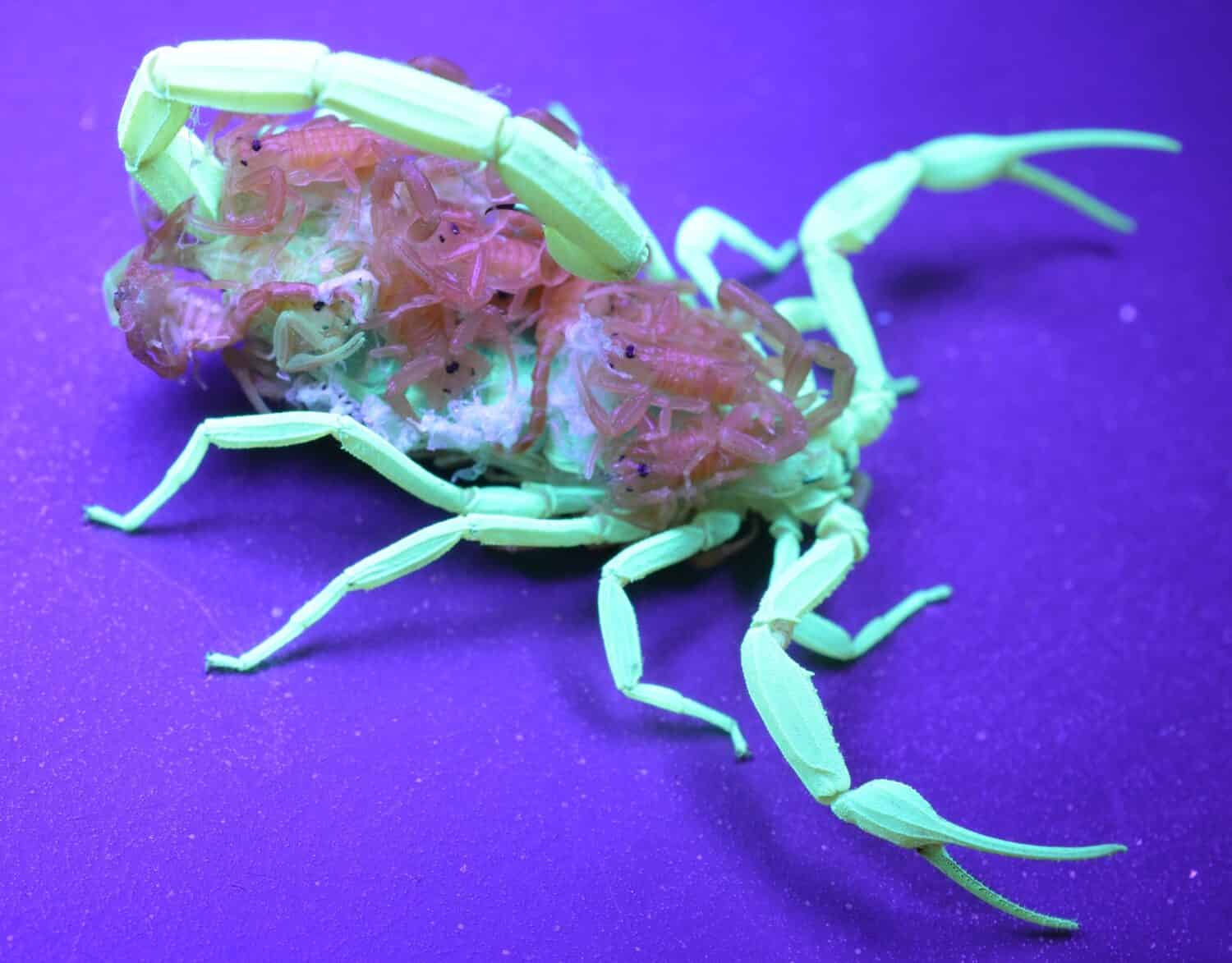
Some scorplings might be more fluorescent than others.
©James C. Bartholomew/Shutterstock.com
One amazing baby scorpion fact is that they have a glow-in-the-dark capability. Some baby scorpions (scorplings), particularly in certain species, can fluoresce under ultraviolet (UV) light. Their exoskeletons contain unique compounds that emit a greenish-blue glow when exposed to UV light. This ability can evolve as they molt and grow, as their exoskeleton chemical composition might change.
The UV fluorescence in baby scorpions is attributed to specific chemicals in their exoskeleton, primarily beta-carboline compounds. They are fluorescent, which means they absorb UV light and re-emit it at longer wavelengths within the visible spectrum, creating the characteristic greenish-blue glow.
Not all scorpion species exhibit UV fluorescence, and the intensity and patterns of fluorescence can vary among those that do. For example, the Arizona bark scorpion (Centruroides sculpturatus), which lives in the southwestern United States and parts of Mexico, is highly venomous and famous for its distinctive fluorescence. When exposed to UV light, Arizona bark scorpions emit a vibrant greenish-blue glow.
This fluorescence happens on various parts of their body, including the exoskeleton, pincers, and the venomous stinger. The intensity of the fluorescence can vary between individuals among the same species.
The scientific community has yet to entirely understand for what purpose baby and adult scorpions exhibit UV fluorescence. Various hypotheses have been proposed regarding the purpose of scorpion UV fluorescence.
Luring Prey
One theory suggests that scorpions use their fluorescence to attract prey. Some insects are known to be attracted to UV light sources, so scorpions might use their fluorescence to mimic such a light source and lure unsuspecting insects closer for an easy meal.
Predator Deterrence
It’s also possible that scorpions might use fluorescence to deter predators. The bright glow may serve as a warning signal to potential threats, indicating that the scorpion is venomous and should be avoided.
Communication
According to some theories, UV fluorescence could play a role in intraspecific communication among scorpions, particularly during courtship rituals or territorial disputes. However, more research is needed to confirm this.
Thermoregulation
Some studies have suggested that UV fluorescence might assist in thermoregulation, helping scorpions manage their body temperature.
2. Baby Scorpions Are Also Venomous
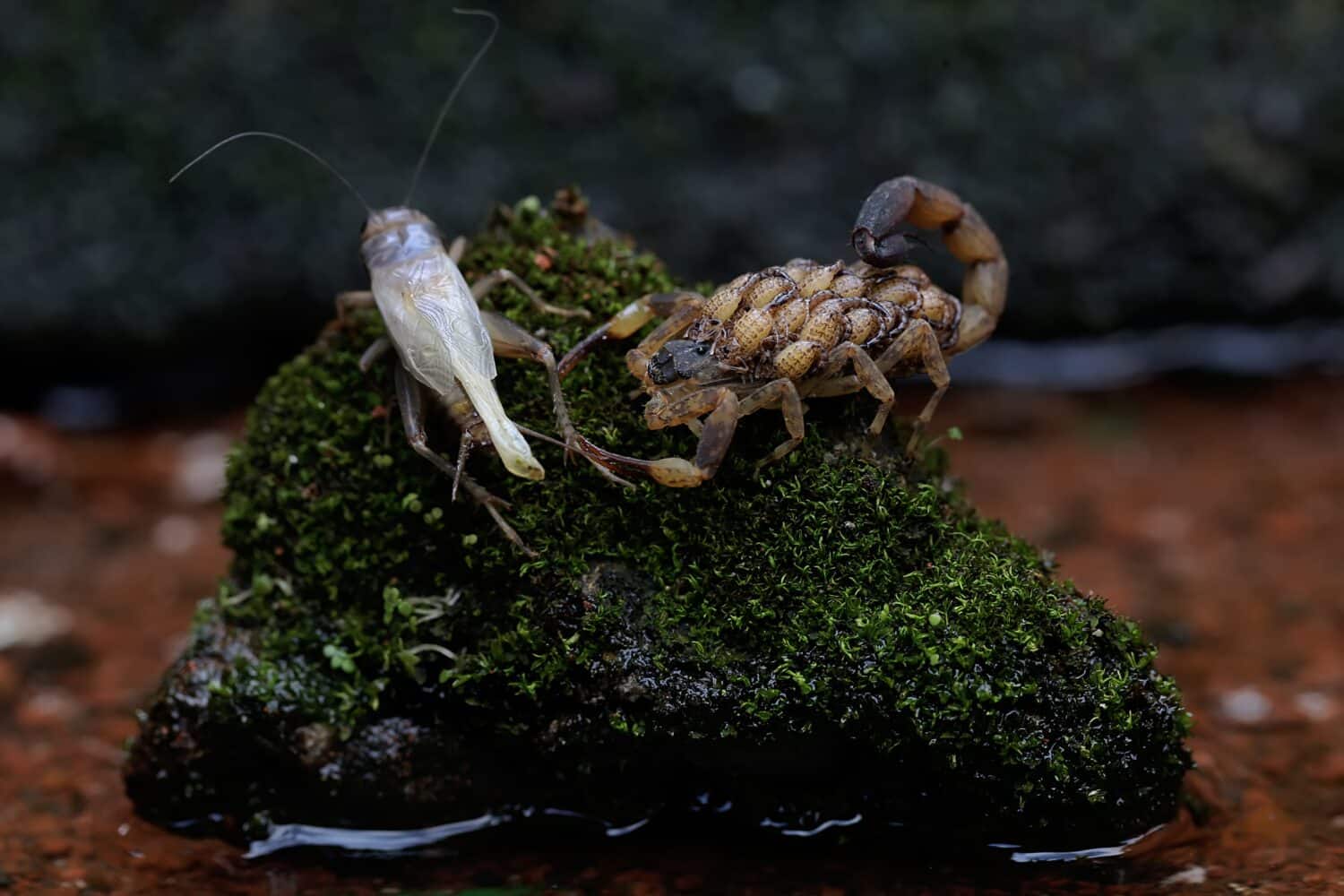
Baby scorpions learn major hunting skills from their mothers.
©I Wayan Sumatika/Shutterstock.com
One of the most distinguishing features of scorpions, even in their juvenile form, is their venomous stinger, located at the end of their segmented tail. Baby scorpions possess this venomous weapon from birth, allowing them to paralyze or immobilize their prey. While their venom may not be as potent as adult scorpions, it is still sufficient to subdue smaller insects and arthropods.
3. Baby Scorpions Are Predators Right From Their Birth
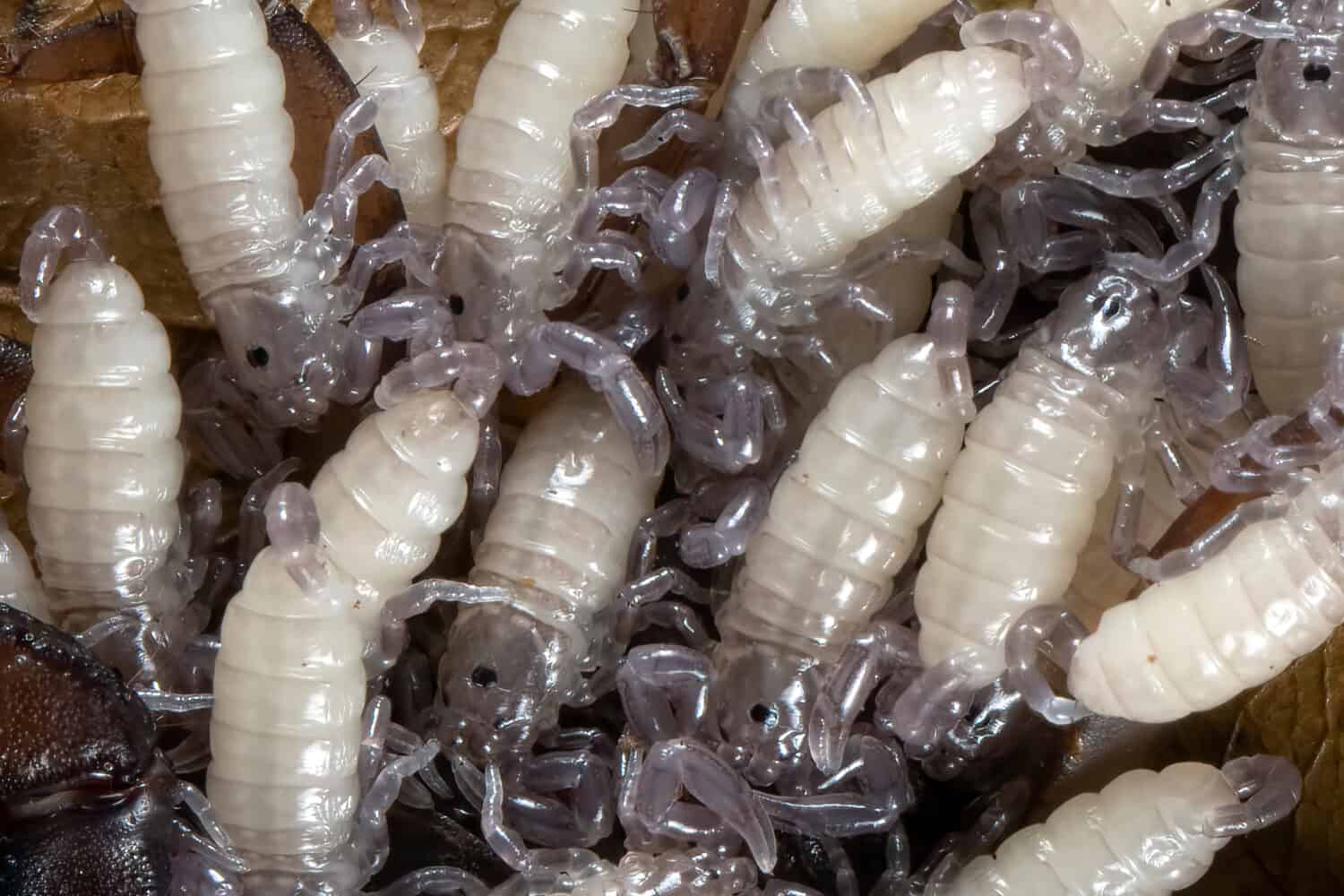
The scorplings’ stingers and pincers are enough to hunt small prey.
©Kurit afshen/Shutterstock.com
The babies display an innate predatory behavior from the moment they are born. They rely on a combination of tactile and chemical sensory cues to detect nearby prey. Once they sense vibrations or chemical signals indicating the presence of potential food, they strike with surprising speed and accuracy.
Baby scorpions also develop their hunting skills through experience, they learn to gauge the distance to their prey and refine their hunting techniques with each successful capture. As they are not as agile and fast as adults, they must rely on hiding spots and patience to secure a meal. Scorplings also target prey that is appropriately sized for their capabilities.
Baby scorpions are typically ambush predators. They use their pincers and stinger to grasp and immobilize prey that ventures too close. Their ability to remain motionless for extended periods, combined with their well-camouflaged exoskeleton, allows them to blend into their surroundings while waiting for prey to approach.
While baby scorpions primarily feed on small insects, such as ants, beetles, and even other arachnids like spiders, their diet can vary depending on their environment and available prey. They are opportunistic feeders, consuming whatever suitable prey comes within their reach.
4. Baby Scorpions May Exhibit Social Cannibalism
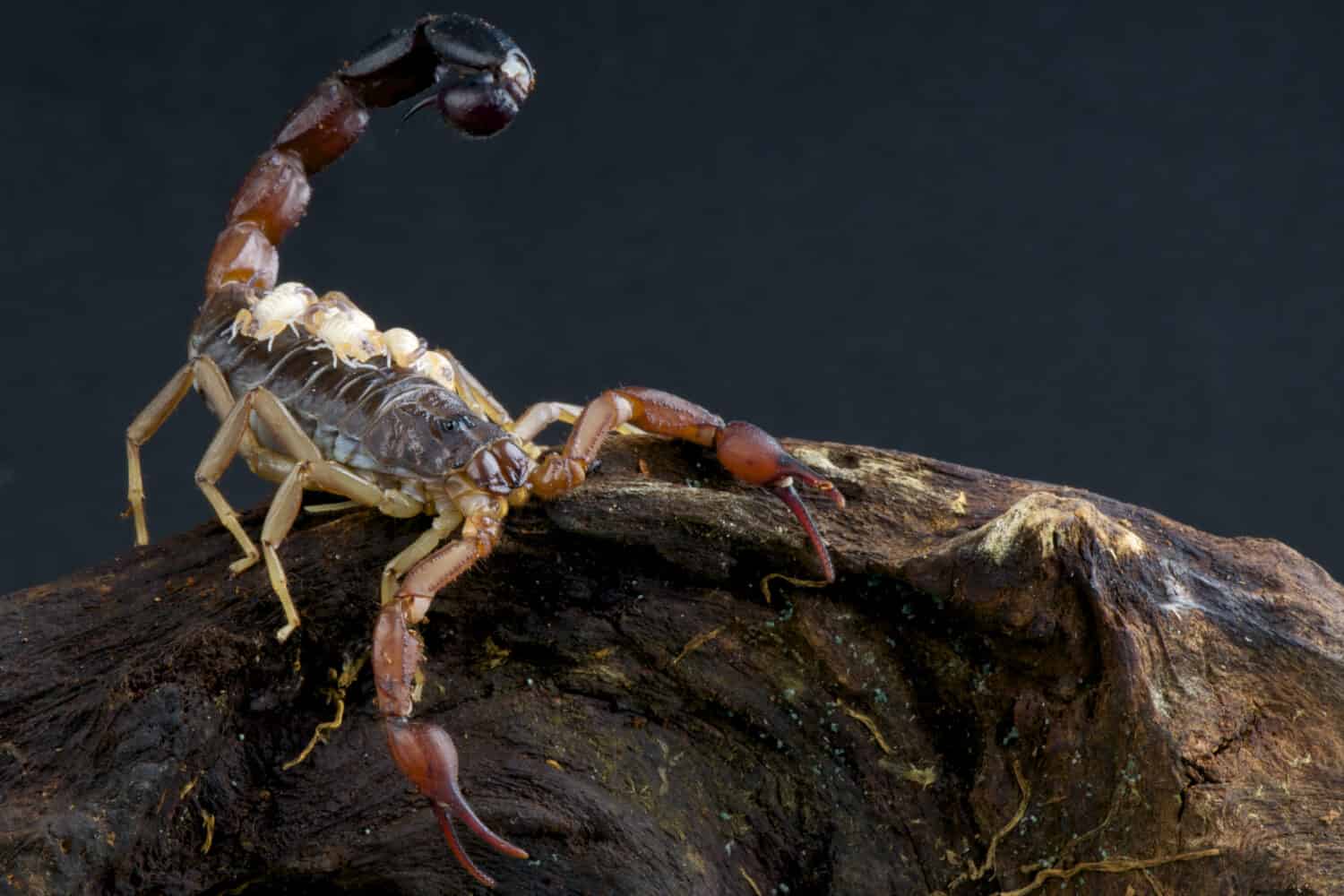
In case of scarce food, cannibalism from the mother or between the siblings is common.
©reptiles4all/Shutterstock.com
In some species, including the Arizona bark scorpion, baby scorpions may exhibit cannibalistic behavior towards their siblings, especially when food is scarce.
But baby scorpions are also at risk of cannibalism from their mother. In certain situations, if food is lacking, the mother scorpion may consume her own young to increase her chances of survival.
5. Baby Scorpions Leave Their Mothers to Avoid Sibling Competition
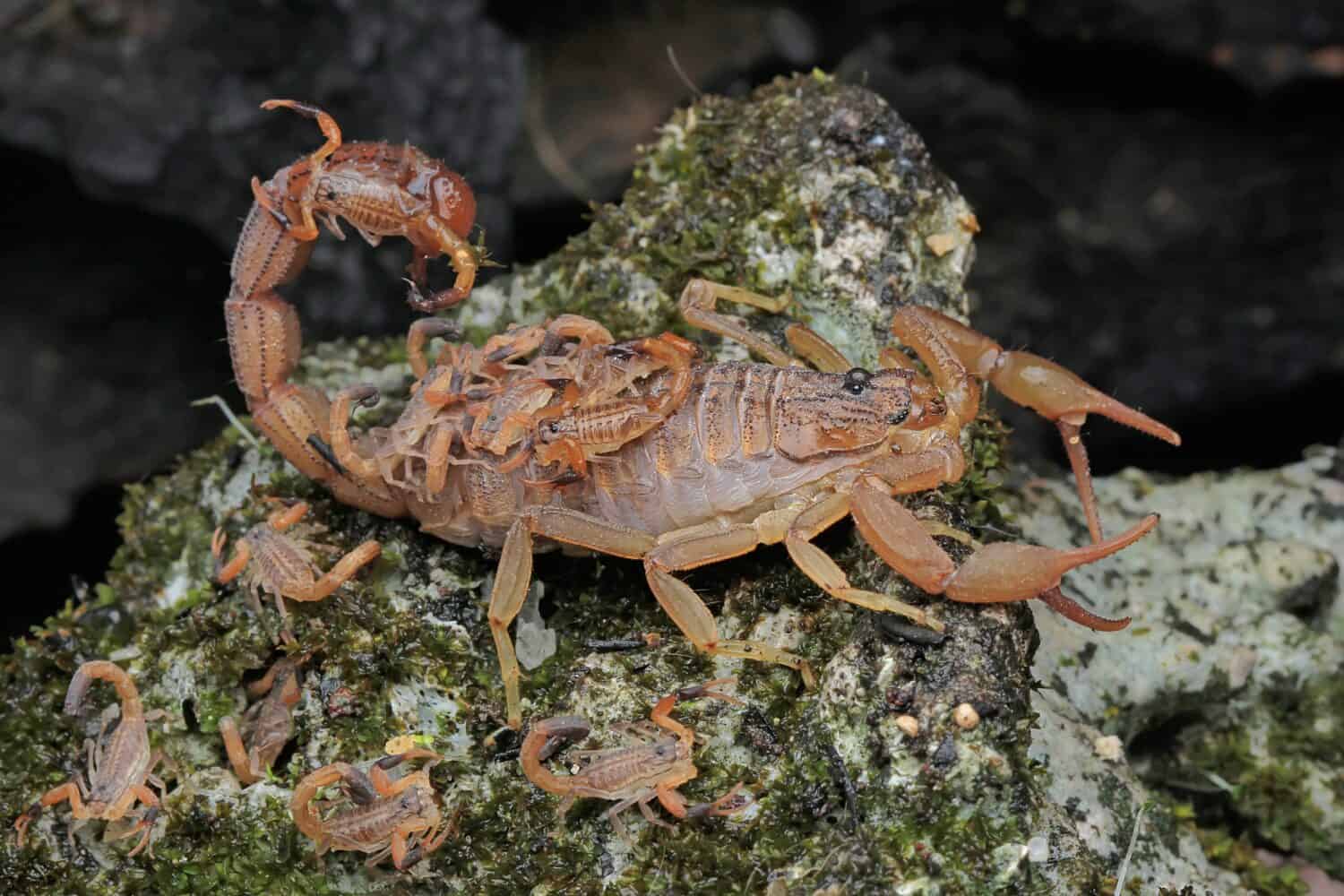
Scorplings often leave their moms after their first molts.
©I Wayan Sumatika/Shutterstock.com
Once baby scorpions have matured and become more self-reliant, they leave their mother’s protection and disperse into the surrounding environment. This dispersal helps avoid competition with siblings and reduces the risk of cannibalism. Baby scorpions start leaving their moms after their first molt. Some can stay for up to two years.
6. Baby Scorpions Are Very Vulnerable

Living on their mothers’ back help protect scorplings from predators.
©Kurit afshen/Shutterstock.com
Baby scorpions are highly vulnerable during their early stages of life. Right at birth, their exoskeletons are soft, making them more susceptible to predators and environmental conditions. As tiny creatures, their limited mobility makes them vulnerable to predators, including larger arachnids and small vertebrates.
Some species of baby scorpions have evolved to resemble ants. This mimicry helps them avoid detection by potential predators that might not recognize them as scorpions and by ants, which are known to be aggressive towards other intruders.
Baby scorpions go through several stages of development, each marked by a molt. Their exoskeletons harden through the stages. The baby scorpions also shed their previous exoskeletons to accommodate their increasing size. These stages are called instars. As they progress through instars, they gain new physical features and grow in size, eventually reaching adulthood and, with it, greater independence and survival skills.
While baby scorpions face many dangers, those that survive the initial stages can live for several years, with some species reaching an average lifespan of three to five years and others even longer.
FAQs (Frequently Asked Questions)
How do scorpions reproduce?
The reproduction process starts with courtship, where the male and female scorpions engage in a series of behaviors to assess each other’s suitability as mates. Once the courtship is successful, the male transfers his sperm to a particular structure called a spermatophore, deposited on the ground or another surface.
The male then guides the female over the spermatophore so that she can take up the sperm into her reproductive organs. Fertilization occurs internally, and the female stores the sperm for later use in fertilizing her eggs. After fertilization, the female carries the developing embryos in her body. The gestation period varies among scorpion species but typically lasts several months.
Unlike many other arachnids, scorpions give birth to live young instead of laying eggs. They are born alive and fully formed and crawl onto their mother’s back immediately after birth. Depending on the species, a female scorpion can simultaneously give birth to anywhere from a dozen to over a hundred baby scorpions.
What are baby scorpions called?
Baby wolf spiders are called scorplings or nymphs.
How big are baby scorpions?
Baby scorpions’ size varies depending on the species and its developmental stage. Generally, when scorplings are first born, they may measure anywhere from 1 to 5 millimeters (0.04 to 0.2 inches) in length.
What do baby scorpions eat?
Right after birth, their mother feeds them by regurgitating pre-digested prey. But as soon as they grow up, baby scorpions start hunting alone, waiting and hiding.
Baby scorpions have a diet consisting of small prey items they can capture and subdue with their pincers and venomous stinger. They feed on small insects and arthropods like ants, beetles, termites, etc. They might consume young spiders or small crustaceans if they inhabit the same environment.
Where do baby scorpions live?
Baby scorpions, as well as adults, live in various parts of the world except Antarctica. They adapt and inhabit multiple environments, from deserts to tropical forests, temperate areas, and even in some urban settings.
Thank you for reading! Have some feedback for us? Contact the AZ Animals editorial team.





